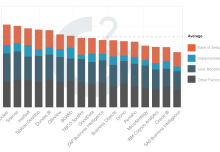 It’s been estimated that there will be 40 zettabytes of data on the planet by 2020 (source: www.forbes.com), so it stands to reason that big data and analytics have becomes so important to current marketing efforts. Practically every business has an online component these days, from large corporations to small start-ups, and marketers are always finding ways to use the data culled from customer interactions, Facebook likes and tweets to improve their business’s visibility. On the surface, this seems easy; after all, anybody can put together a Facebook page, Twitter account or even a basic functional website. However, actually using big data analyics tools to your business’s advantage is surprisingly complicated.
It’s been estimated that there will be 40 zettabytes of data on the planet by 2020 (source: www.forbes.com), so it stands to reason that big data and analytics have becomes so important to current marketing efforts. Practically every business has an online component these days, from large corporations to small start-ups, and marketers are always finding ways to use the data culled from customer interactions, Facebook likes and tweets to improve their business’s visibility. On the surface, this seems easy; after all, anybody can put together a Facebook page, Twitter account or even a basic functional website. However, actually using big data analyics tools to your business’s advantage is surprisingly complicated.
Like every other marketing effort, putting together a big data strategy takes time and effort, not to mention a little bit of luck. If you want your business to truly thrive in the 21st Century, here are some things to remember as you develop your big data strategy.
Have a Specific Goal in Mind
When you develop a big data strategy for your business, it’s important to have a specific goal in mind. You obviously know what you’re trying to do with your business, but you may not know what you need to accomplish with a big data strategy at first. The best way to figure out how to accomplish this is to consider what issue you need this data to address. In most cases, this involves gathering demographic data from your customers through previous transactions, but it can also mean gathering data through social media. This is of course not that much different from the advertising efforts that have existed for years, but there is one crucial difference in marketing today. This brings us to our next element of any big data strategy…
Listen to Your Clients
Gathering demographic data from clients has been a go-to strategy for marketers for years, but the data-gathering methods in the past have never been as effective as those that exist today. Data gathered through questionnaires was outdated the moment it was received (source: www.data-informed.com), but modern communication technology allows businesses to communicate with clients in real time. Many businesses use Twitter, Facebook and even SMS messaging to address their customers much more directly, which in turn allows them to adjust their marketing strategies on the fly if need be. It also allows marketers to target specific clients and tailor their advertisements for them.
Make Changes As Necessary
Finally, you should always remember that a big data strategy involves at least some experimentation and trial and error. While you can gather a lot of information and analytics about your clients, actually developing marketing strategies that will work in your favor is difficult. Be careful about relying on any one strategy too much, and be ready to make changes in real time as your strategy grows.


